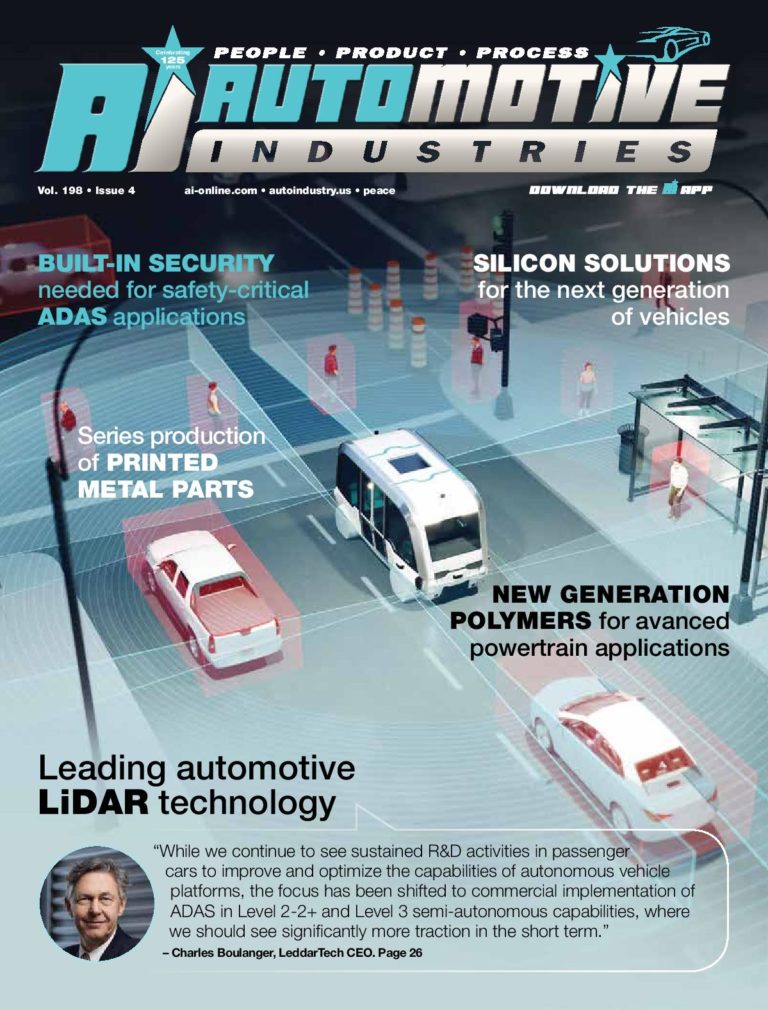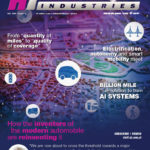While it will be some time before fully autonomous vehicles are a common sight on public roads, the technology developed for these vehicles is already being used to make roads safer and in controlled environments.
OEMs are installing LiDAR (light detection and ranging) systems in buses and delivery vehicles which have numerous blind spots due to their size and shape. With their limited visibility and maneuverability, delivery vehicles as well as large road vehicles such as buses and semi-trailers are at high risk of causing road accidents or structural damage to buildings and infrastructure.
Operators of large vehicles also often have to work in challenging weather and deal with various distractions that may temporarily affect their attention, according to Canada-based LeddarTech. Thanks to LiDAR technology, these daily challenges mean that safety for all commercial and delivery vehicles will be enhanced by features such as collision avoidance, turn assist, and blind spot monitoring. LiDAR also opens the way for the use of autonomous delivery vehicles and truck platooning in order to increase efficiency and reduce transport costs, LeddarTech adds. LiDAR is also being used to guide autonomous shuttles in controlled environments such as warehouses, airports and campuses. In order to meet this growing demand, OEMs need reliable access to large volumes of automotive-grade solid-state LiDAR’s (SSLs). LeddarTech addresses this need through its auto and mobility LiDAR platform, which provides Tier 1 and automotive system integrators, the technology required to develop and produce tailored SSL solutions to specific OEM requirements. The LeddarEngine™, which combines the LeddarCore™ systems-on-chip (SoC) with patented digital signal processing software, sets a new standard for highly integrated, customizable SSL solutions that are optimized for mass deployment in ADAS and self-driving cars,” says the company. LeddarTech’s LeddarEngine has been proven in the field through its use in autonomous shuttles, delivery vehicles and robot taxis, where the solid-state LiDAR sensors improve spatial awareness and obstacle detection up to 360° around the vehicles. Recently, the company introduced the LeddarTM Pixell, a 3D solid state cocoon flash LiDAR with 180-degree field of view. “The Leddar Pixell provides highly reliable detection of pedestrians, cyclists and other obstacles in the vehicle’s vicinity and is ideal for use in perception platforms that are meant to ensure the safety and protection of vulnerable road users (VRU).
It enables a detection cocoon that surrounds the vehicle to provide complete blind spot coverage with no dead zones in the illuminated field of view.,” continues LeddarTech
Automotive Industries (AI) asked LeddarTech CEO Charles Boulanger whether the advent of connected and autonomous vehicles is going to take longer than predicted.
Boulanger: 2019 appears to have been the year of the ‘’reality check’’. Based on recent reports, press articles, and automotive company declarations, it has become obvious that putting fully autonomous vehicles on the road is proving to be a lot more challenging than initially expected and forecasted. And it is especially true with regards to vehicles operating outside of geofenced areas. Many key players in the automotive sectors have recently announced delays or pushbacks in their autonomous vehicle initiatives. The industry seems to now acknowledge that the leap from Level 3 features to Level 4/5 is orders of magnitude in complexity and will take a few more years than anticipated. Hence, while we continue to see sustained R&D activities in passenger cars to improve and optimize the capabilities of autonomous vehicle platforms, the focus has been shifted to commercial implementation of ADAS in Level 2-2+ and Level 3 semiautonomous capabilities, where we should see significantly more traction in the short term. The Mobility market is where we should first see implementation of Level 4- Level 5 in controlled use-cases.
AI: What advantages does LiDAR have over technology like radar, video cameras and ultrasonic sensors for autonomous vehicles?
Boulanger: While all those detection technologies prove useful in specific automotive applications, they also have well-known limitations. For example, sonar is low-cost but has very limited range and low resolution. Radar has issues detecting certain materials or surfaces and does not do as well with static objects. Cameras can’t provide range information and are significantly impacted by important weather or lighting conditions. LiDARs are particularly strong at accurately measuring distances over long ranges, providing highly valuable information on the vehicle’s surroundings and potential obstacles in the vehicle’s path. A LiDAR, unlike cameras, emits its own signal, and functions independently of the ambient lighting. LiDAR can therefore achieve fantastic results day and night without any loss of performance. The vast amount of data generated by the LiDAR results in a very accurate 3D reconstruction of a scene. Every light pulse emitted provides specific information about the relative distance and size of the detected object and allows the system to create a precise three-dimensional mapping of the environment. If there is an object in front of the vehicle, LiDAR can detect how far away and how big it is. These insights are highly valuable for the navigation system to interpret its environment and make decisions, and that is why you find LiDARs in the vast majority of AV platforms under development today.
AI: How are LiDAR technologies changing to overcome challenges such as being unable to perform optimally in bad weather?
Boulanger: Inclement weather conditions such as snow, rain, or fog change the refractive index of the transmission medium and indeed reduce the effective range of a LiDAR sensor. Radar’s high immunity to weather conditions is one of the key reasons why they are also incorporated in the design of most automotive sensor suites. That being said, the impacts of weather conditions on LiDAR can be significantly mitigated through the use of advanced signal post-processing and noise filtering algorithms.
AI: What role do you see LiDAR playing in the public transportation systems of the future?
Boulanger: LiDARs are already being deployed in applications that contribute to making public transportation safer. For example, public transit companies integrate our LiDARs on buses in order to reduce driver blind spots. Most autonomous shuttle manufacturers use LiDARs for geo-positioning as well as for the protection of vulnerable road users around the vehicle. By improving the detection and ranging capabilities of these autonomous vehicles, LiDAR plays a key role in enabling and accelerating the deployment of commercially viable and safe automated public transit in our cities, neighborhood, or campuses.
AI then asked Frantz Saintellemy, President and Chief Operating Officer, LeddarTech, what strategy the company is using to expand its geographical reach.
Saintellemy: The automotive and mobility markets are truly global, and so is our customer base. LeddarTech has expanded greatly in the past 18 months. In addition to our R&D facility in Quebec City, Canada, we have opened an R&D facility in Linz, Austria, and two Canadian research hubs: the Automotive Center of Excellence in Toronto that focuses on AI and perception; and an additional R&D location in Montreal that focusses on our core software and signal processing, called LeddarSP™. We have also significantly expanded our geographical reach in sales and customer-application support with sales divisions in Europe, North America and Asia while also signing agreements with various distribution partners throughout the world.
AI: How has LeddarTech built relationships with automotive OEMs?
Saintellemy: LeddarTech’s business model is not to sell finished LiDAR products directly to automotive OEMs: we have developed a LiDAR platform around our LeddarEngine, a LiDAR core that enables Tier 1 manufacturers and LiDAR developers to build and manufacture differentiated LiDAR solutions to meet specific automotive OEM requirements. In this context, we define ourselves more as a LiDAR technology provider than a LiDAR vendor. We engage with OEMs directly to introduce our LiDAR technology, to understand their requirements for various applications from ADAS to AD and develop reference designs for early R&D and testing. However, our Tier 1 partners already have established relationships with all major OEMs worldwide, possess tremendous engineering, manufacturing, and quality control capabilities, and are in an ideal position to meet the stringent requirements of automotive components and systems. Therefore, we aim to leverage the existing industry supply chain by providing the core technology and working hand-in-hand with these Tier 1s, for the benefit of all involved. Our LeddarEngine is one of the first LiDAR technologies to be designed to meet ISO 26262 – a necessary requirement for automotive deployments














































 Silicone solutions for the next generation of vehicles
Silicone solutions for the next generation of vehicles “Game-changing” combination of autonomous technology and payment systems
“Game-changing” combination of autonomous technology and payment systems Advanced PP compounds for new generation of vehicles and circular economy
Advanced PP compounds for new generation of vehicles and circular economy Sustainable and high-performance polymers for automotive applications
Sustainable and high-performance polymers for automotive applications Intelligent dash-cams ready for series OEM installation
Intelligent dash-cams ready for series OEM installation Built-in security needed for safety-critical ADAS applications
Built-in security needed for safety-critical ADAS applications


